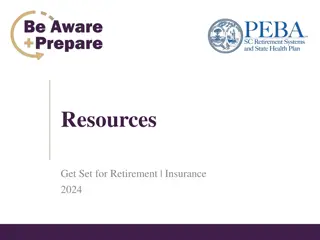Understanding Health Insurance and Its Benefits
Health insurance is essential for everyone to manage medical costs. It provides financial security by spreading the expenses across a large group of individuals. Different types of health insurance, such as private and government-funded, offer various coverage options for individuals and organizations. Health insurance helps people budget for healthcare expenses and ensures access to necessary medical care.
Download Presentation

Please find below an Image/Link to download the presentation.
The content on the website is provided AS IS for your information and personal use only. It may not be sold, licensed, or shared on other websites without obtaining consent from the author. Download presentation by click this link. If you encounter any issues during the download, it is possible that the publisher has removed the file from their server.
E N D
Presentation Transcript
INTRODUCTION Everyone no matter how healthy needs medical care at some point in time. This may be in form of preventive care or treatment for sicknesses and injuries. With medical care comes payment of fees in one form or the other. Affordability of such fees at the point of use may be difficult. Health insurance provides a form of financing which make payment for the fees relatively easier. .
INTRODUCTION CONTD. Health insurance is an institutional and financial that helps households, individuals and organizations to set aside financial resources to meet costs of medical care in the event of illness. The advantage of insurance is that it converts unpredictable future expenses into payments that can be budgeted for in advance. From this you will observe that health insurance scheme option in health care financing significantly differs from user-fees which in some places are described as cash and carry
Definition Of Health Insurance Health insurance is a system in which prospective consumers of care make payment to a third party in the form of an insurance scheme, which in the event of future illness will pay the provider of care for some or all of the expenses incurred. Health insurance is a type of insurance whereby the insurer pays the medical costs of the insured if the insured becomes sick due to covered causes, or due to accidents.
Health Insurance Contd. The insurer may be a private organization or a government agency. Health insurance is an agreement between a person, who is called the policyholder, and an insurance agent. Insurance agents or carriers are organizations that offer financial protection in case of illness or injury and pays for the policyholder s medical treatment.
Health Insurance Contd. The fundamental concept of health insurance is that it balances costs across a large, random sample of individuals. For instance, an insurance company has a pool of 1000 randomly selected subscribers with each paying N1000.00 per month. Fifty of them get really sick that month while the others stay healthy, which means the insurance company, can use the money of the paid by the healthy people to treat the sick persons
Types of Health Insurance 1. Private Health Insurance Private health insurance is a contract between an insurance company and the customer and in the private sector. Private insurance can be for groups like companies, labour unions, professional association or for individuals. Private: This is through employer owned on-sight health facilities or through contract with outside providers, contribution payable is based strictly on the needs of the individual i.e. the higher the health needs of the contribution the higher the payment.
Types of Health Insurance CONTD. 2 . Public Health Insurance The public sector third party may be Parastatals, insurance scheme, government, and social security and sometimes the providers. With the publicly funded health insurance the good and the bad risks all receive coverage without regard to health status, which eliminates the problem of adverse selection and amplifies the problem of moral hazard.
Types of Health Insurance CONTD. 3. Social Insurance Insurance program financed by government through tax revenues that guarantee citizens financial benefits for events which are beyond individual control, such as old age, disability and poor health. Payment is irrespective of the needs and is usually based on employment and income.
Types of Health Insurance CONTD. _ Based on the principle of solidarity _ Contribution based on ability to pay _ Resources are pooled together among a large population _ It enhances security of each individual in the group. Higher income earners will subsidize those with lower income and those with lower health needs will subsidize those with higher health needs
Types of Health Insurance CONTD. 4. Community Sponsored Insurance A community based program which normally operates in the rural areas and mostly localized e.g. health care scheme in Thailand, Tsonga in Kwara State, Nigeria
Types of Health Insurance CONTD. Other types of HIS include 5. Direct Here the Health Insurance Scheme builds or rents its own health care premises exclusively for the use of the insured persons. 6. Indirect Here the scheme makes contracts with selected providers for the provision of defined services at negotiated prices, the authority rather than the insured persons makes the payment.
Types of Health Insurance CONTD. 7 Reimbursement The patient buys his own medical care in the private market and then sends the receipted bills to the insured who reimburses the insured person either for part of the full cost or on the basis of standard payment for a particular service which will normally be well below the prices actually paid
Problems Of Health Insurance This include: Increasing cost of health care Some private insurance companies charge people at different rates based on their own personal health Some medical problems may not be covered by the scheme Health care recipient is not involved in negotiating the cost of care. Some health care providers have popular and unpopular ways of controlling these costs. Some providers may have different rates for the same procedure for those insured and those not insured
Problems Of Health Insurance CONTD. Problems With Private Health Insurance There two main problems and these are adverse selection and moral hazard. Adverse selection - Describes the tendency for only those who will benefit from insurance to buy it or participate in it. Adverse selection can leave an insurance company with primarily sick subscribers and will have the problem of balancing out the cost of medical expenses with a large number of healthy subscribers. This is because unhealthy people are more likely to purchase health insurance because they anticipate heavy medical bills whereas those who consider themselves to be healthy may decide that medical insurance is an unnecessary expense
Problems Of Health Insurance CONTD. If they see a doctor once in a year and it costs N500.00, that much better than making monthly insurance of N600.00. Moral hazard Describes the state of mind and change in behaviour that results from the knowledge the health insurance will take care of medical bills and people therefore overuse medical care since they do not incur out- of pocket expenses. Where health insurance is in practice, people who do not have insurance cover or are under- insured may wait for too long out of fear of high medical bills until the illness become life threatening.
Conclusion Health insurance is an option of health financing that is used in most developed countries and increasing number of developing countries are also practising health insurance scheme. It converts unpredictable future expenses into payments that can be budgeted for in advance. There are various types of health insurance scheme. The scheme now appear to be a sustainable way of financing health care and reduces the problem of cash and carry health financing and this to a large extent reduces the emergency financial burden when household need to utilize health care.
NATIONAL HEALTH INSURANCE SCHEME (NHIS) The history of health insurance scheme in Nigeria is over 3 decades but not until 1997 that the scheme was officially launched. The implementation of the scheme in Nigeria is planned to be in phases commencing with pubic civil servants. Private sector involvement is incorporated into the scheme with the use of Health Maintenance Organizations (HMOs) to collect contributions from participants and also pay providers of services.
NHIS CONTD. Historical Perspective In Nigeria the first search for health insurance system started in1962 during the first republic. The federal government invited Dr. Halevi through the International Labour Organization (ILO) to look into starting an health insurance system in Lagos. Dr. Halevi supported the system but the Nigerian Medical Association opposed it. The civil war years, caused the matter to be shelved but was resuscitated by the National Council on Health in the early 80s, two decades after. The Minister of Health, Admiral Patrick Koshoni, on the advice of the National Council of Health commissioned a study led by Professor Diejomaoh of the Nigerian Institute for social and economic research (1984).
NHIS CONTD. This was later followed in 1965 by a feasibility study chaired by Mr. Yinka Lijadu of the National Insurance Corporation of Nigeria which found the scheme feasible, workable and desirable in Nigeria. Finally, in 1988, Professor Olikoye Ransome Kuti, commissioned the National Committee on Establishment of the NHIS, chaired by Emma-Eronini and recommended the capitation model, which is easy to run and almost tailor made for our health system and traditions. The United Nations Development Programme (UNDP) and International Labour Organization (ILO) consultants along with others conducted their own studies in Nigeria to provide costing, draft legislation and implementation guidelines for establishing the scheme in 1992.
NHIS CONTD. Then the federal executive council, which had given its approval in 1989, directed federal ministry of health in 1993 to start the scheme, which was launched in 1997, and finally signed to law in May 10, 1999 by the then Head of State General Abdulsalam Abubakar
NHIS: The Nigerian Concept It is a social health security arrangement to provide financial security to the citizens against unforeseen ill health. A scheme established by law number 35 of 1999 to improve health care delivery by providing a sustainable alternative source of funding health care services. The scheme works on the principle that higher income earners will subsidize those with lower income; and those with lower health needs will subsidize those with higher needs. Resources are pooled among a large population so that sufficient fund will be made available to take care of individuals needing health care at any one time. It will be a solution to the problem of inappropriate use of the levels of health care leading to unnecessary costs and underutilization
NHIS: The Nigerian Concept CONTD. It guarantees access to health care as of right to participants. The establishment of the scheme was informed by the general poor state of the nation s health care services especially in relation to accessibility, quality of services rendered, utilization and distribution, the excessive dependence and pressure on the government provided health services, and dwindling funding in the face of rising cost of heath care services
Objectives of the scheme 1. To ensure that every Nigerian has access to good health care services. 2. Protecting families from the financial hardship of huge medical bills. 3. To ensure equitable distribution of health care costs among different income groups. 4. Limiting the rise in the cost of health care services. 5. To improve and harness private sector participation in the provision of health care services. . The objectives of NHIS include:
Objectives of the scheme CONTD. 6. To ensure equitable patronage of all levels of health care. 7. To maintain high standard of health care delivery services within the scheme. 8. To ensure availability of funds to the health sector for improved services. 9. To ensure efficiency in health care services. 10. To ensure adequate distribution of heath facilities within the federation
Health Care Benefits of the Scheme The benefits derived from participating in the scheme are defined by law, are fairly comprehensive and include the following: Defined elements of curative care such as: Out patient attendance Maternity care for up to four births for every insured person Consultation with defined range of specialist Hospital care in a public or private hospital in a standard ward, during a stated duration of stay, for physical or mental disorders. Eye examination and care, excluding tests for and the actual provision of spectacles
Health Care Benefits of the Scheme CONTD. Defined dental care: 1. Consultant, Oral examination, preventive care and pain relief 2. Preventive care including immunization, family planning, antenatal,post-natal care and health education. 3. Prescribed drugs and diagnostic tests 4. Prostheses and rehabilitation From the above it is evident that the contribution of a small affordable amount buys a lot in terms of health care
How the Scheme Works For participation in the scheme, contributors will first register with an NHIS approved Health maintenance Organization (HMO) and thereafter register with a primary health care provider of his choice for an approved list of providers supplied HMOs. When a contributor is registered he will be issued an Identity card (ID) card with a personal identification number. In the event of sickness the contributor presents his ID card to his chosen primary health care provider (PCP) for treatment.
How the Scheme Works CONTD. A contributor has a right to change his PCP after a minimum period of six months if he is not satisfied with his services. The HMO will make payment for services rendered to him to the health care provider. A contributor may be asked to make a small co-payment per prescription at the point of service. A contribution made by the insured person entitles himself or herself, spouse and four children under the age of 18 years to full health benefits.
How the Scheme Works CONTD. However students in school upon to the age 25years qualify as dependants. Extra contributions will be required for additional dependants. Contribution to be made by formal sector employees for health benefits under the scheme will be 15% of wages, the payment of which will be by both the employee and the employer.
How the Scheme Works CONTD. The employee pays 5%, while the employer makes up the remaining 10%. The employee s part of the contribution is to be deducted from his pay with the employer adding his own and subsequently forwarding the total payment to the appropriate quarters The implementation of the scheme is planned to be in phases to cover all Nigerians categorized as follows: 1. Employers in the formal sector (public and private) their contribution will be paid by their employers and those in public sector by the federal state local governments Parastatals and agencies as appropriate. 2. Self-employed person (market women, traders, artisans, farmers and Businessmen etc) they will be encouraged to pay their contributions either by themselves or through cooperatives formed by them.
How the Scheme Works CONTD. 3. Rural dwellers for this group suitably priced programmers designed for them will be implemented in consultation with various organizations such as the community banks, cooperatives, local state and federal governments as well as donor agencies and other NGOs. 4. Vulnerable groups which include the unemployed, the aged, the disabled, the street children, the retarded and the retirees their
How the Scheme Works CONTD. contribution will be paid on their behalf by the federal government, state government and local governments NGOs, local community and philanthropists. It is however important to emphasize that coverage will be phased starting with employees in the formal sector representing a definable group.
CONCLUSION The National health Insurance Scheme is set to provide access to quality health care to all Nigerians. Quality, accessible and sustainable health care that is adequately funded, will be guaranteeing a healthy populace, also provide an economically productive one, the benefits of which will be accruable to the individual, the organization and to the Government. The scheme is already being implemented in the country and started with workers in the public sector























